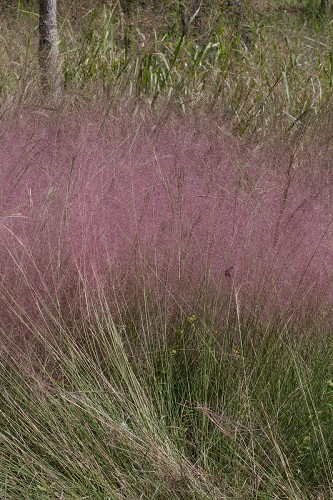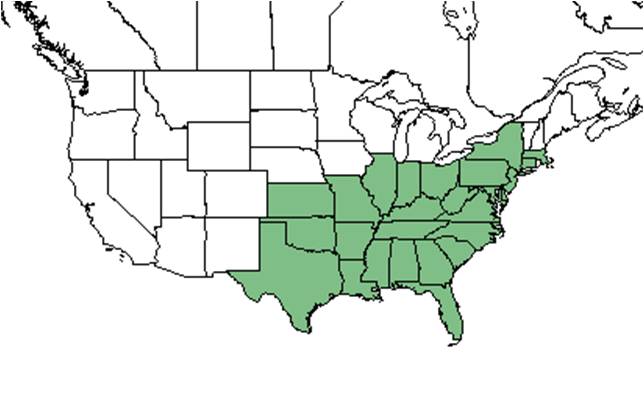Difference between revisions of "Muhlenbergia capillaris"
| Line 27: | Line 27: | ||
"Cespitose perennial; culms 5-12 dm tall, nodes and internodes glabrous. Leaves primarily basal; blades flat or involute, to 3 dm long, 103 mm wide; sheaths scaberulous; ligules 2-5 mm long. Panicle open, diffuse, delicate, 2-5 dm long, 1-2 dm broad; branches capillary, spreading, scaberulous. Spikelets usually purplish, lanceolate to narrowly ellipsoid, 4-5 mm long excluding awn; pedicels capillary, spreading, scaberulous. Glumes usually 1-nerved, usually scaberulous on midrib, scarious, 1st glume body 0.3-1.2 mm long, awn 0.3-1.2 mm long, 2nd glume body 1-1.5 mm long, awn 1-1.5 mm long; lemmas purplish, 3-nerved, scaberulous, body 3-4 mm long, awns 3-12 mm long; paleas purplish, faintly nerved, acuminate, 3-4 mm long. Grain purplish, narrowly ellipsoid, 2-2.4 mm long." - Radford et al 1964 | "Cespitose perennial; culms 5-12 dm tall, nodes and internodes glabrous. Leaves primarily basal; blades flat or involute, to 3 dm long, 103 mm wide; sheaths scaberulous; ligules 2-5 mm long. Panicle open, diffuse, delicate, 2-5 dm long, 1-2 dm broad; branches capillary, spreading, scaberulous. Spikelets usually purplish, lanceolate to narrowly ellipsoid, 4-5 mm long excluding awn; pedicels capillary, spreading, scaberulous. Glumes usually 1-nerved, usually scaberulous on midrib, scarious, 1st glume body 0.3-1.2 mm long, awn 0.3-1.2 mm long, 2nd glume body 1-1.5 mm long, awn 1-1.5 mm long; lemmas purplish, 3-nerved, scaberulous, body 3-4 mm long, awns 3-12 mm long; paleas purplish, faintly nerved, acuminate, 3-4 mm long. Grain purplish, narrowly ellipsoid, 2-2.4 mm long." - Radford et al 1964 | ||
| − | + | <!--==Distribution==--> | |
| − | ==Distribution== | ||
==Ecology== | ==Ecology== | ||
| − | ===Habitat=== <!--Natural communities, human disturbed habitats, topography, hydrology, soils, light, fire regime requirements for removal of competition, etc.--> | + | <!--===Habitat===--> <!--Natural communities, human disturbed habitats, topography, hydrology, soils, light, fire regime requirements for removal of competition, etc.--> |
| − | ===Phenology=== <!--Timing off flowering, fruiting, seed dispersal, and environmental triggers. Cite PanFlora website if appropriate: http://www.gilnelson.com/PanFlora/ --> | + | <!--===Phenology===--> <!--Timing off flowering, fruiting, seed dispersal, and environmental triggers. Cite PanFlora website if appropriate: http://www.gilnelson.com/PanFlora/ --> |
===Seed dispersal=== | ===Seed dispersal=== | ||
According to Kay Kirkman, a plant ecologist, this species disperses by gravity. <ref name="KK"> Kay Kirkman, unpublished data, 2015. </ref> | According to Kay Kirkman, a plant ecologist, this species disperses by gravity. <ref name="KK"> Kay Kirkman, unpublished data, 2015. </ref> | ||
| − | ===Seed bank and germination=== | + | <!--===Seed bank and germination===--> |
| − | ===Fire ecology=== <!--Fire tolerance, fire dependence, adaptive fire responses--> | + | <!--===Fire ecology===--> <!--Fire tolerance, fire dependence, adaptive fire responses--> |
| − | ===Pollination=== | + | <!--===Pollination===--> |
| − | ===Use by animals=== <!--Herbivory, granivory, insect hosting, etc.--> | + | <!--===Use by animals===--> <!--Herbivory, granivory, insect hosting, etc.--> |
| − | ===Diseases and parasites=== | + | <!--===Diseases and parasites===--> |
| − | + | ==Conservation and management== | |
| − | ==Conservation and | ||
==Cultivation and restoration== | ==Cultivation and restoration== | ||
==Photo Gallery== | ==Photo Gallery== | ||
<gallery widths=180px> | <gallery widths=180px> | ||
</gallery> | </gallery> | ||
| − | |||
==References and notes== | ==References and notes== | ||
Radford, Albert E., Harry E. Ahles, and C. Ritchie Bell. Manual of the Vascular Flora of the Carolinas. 1964, 1968. The University of North Carolina Press. 107. Print. | Radford, Albert E., Harry E. Ahles, and C. Ritchie Bell. Manual of the Vascular Flora of the Carolinas. 1964, 1968. The University of North Carolina Press. 107. Print. | ||
Revision as of 20:15, 24 June 2016
| Muhlenbergia capillaris | |
|---|---|

| |
| Photo by John R. Gwaltney, Southeastern Flora.com | |
| Scientific classification | |
| Kingdom: | Plantae |
| Division: | Tracheophyta- Vascular plants |
| Class: | Lilianeae -Monocotyledons |
| Order: | Poales |
| Family: | Poaceae |
| Genus: | Muhlenbergia |
| Species: | M. capillaris |
| Binomial name | |
| Muhlenbergia capillaris (Lam.) Trin. | |

| |
| Natural range of Muhlenbergia capillaris from USDA NRCS Plants Database. | |
Common names: Hairawn muhly
Contents
Taxonomic notes
Synonym: Muhlenbergia capillaris (Lam.) Trin. var. capillaris
Description
"Perennials. Blades usually scaberulous on both surfaces and margins; sheath margins scarious, at least apically; ligules scarious, erose or erose-ciliate. Spikelets 1-flowered. Glumes equaling or shorter than lemmas, lemmas not indurate. Grain enclosed by lemma and palea at maturity." - Radford et al 1964
"Cespitose perennial; culms 5-12 dm tall, nodes and internodes glabrous. Leaves primarily basal; blades flat or involute, to 3 dm long, 103 mm wide; sheaths scaberulous; ligules 2-5 mm long. Panicle open, diffuse, delicate, 2-5 dm long, 1-2 dm broad; branches capillary, spreading, scaberulous. Spikelets usually purplish, lanceolate to narrowly ellipsoid, 4-5 mm long excluding awn; pedicels capillary, spreading, scaberulous. Glumes usually 1-nerved, usually scaberulous on midrib, scarious, 1st glume body 0.3-1.2 mm long, awn 0.3-1.2 mm long, 2nd glume body 1-1.5 mm long, awn 1-1.5 mm long; lemmas purplish, 3-nerved, scaberulous, body 3-4 mm long, awns 3-12 mm long; paleas purplish, faintly nerved, acuminate, 3-4 mm long. Grain purplish, narrowly ellipsoid, 2-2.4 mm long." - Radford et al 1964
Ecology
Seed dispersal
According to Kay Kirkman, a plant ecologist, this species disperses by gravity. [1]
Conservation and management
Cultivation and restoration
Photo Gallery
References and notes
Radford, Albert E., Harry E. Ahles, and C. Ritchie Bell. Manual of the Vascular Flora of the Carolinas. 1964, 1968. The University of North Carolina Press. 107. Print.
- ↑ Kay Kirkman, unpublished data, 2015.